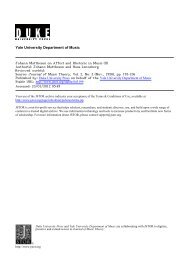Après une Lecture de Liszt: Virtuosity and ... - Free
Après une Lecture de Liszt: Virtuosity and ... - Free
Après une Lecture de Liszt: Virtuosity and ... - Free
You also want an ePaper? Increase the reach of your titles
YUMPU automatically turns print PDFs into web optimized ePapers that Google loves.
19THCENTURYMUSICan opportunity for controlling the rhetoric <strong>and</strong>pacing of the “Dante” Sonata’s thematic transformations.The improvisatory aesthetic of thefollowing examples, with their potential interchangeability(modularity), suggests they mayhave been engen<strong>de</strong>red more by intuition inperformance than by premeditation—Marx’sAnschauung. In other words, some of thesetransitions may have originated at the keyboardwithout <strong>Liszt</strong>’s explicitly intending for them toend up in a composition, but at the moment of“composing,” elements of them were at hisfingertips.The transition between two transformationsof the principal chromatic theme is shown inex. 3a/b <strong>and</strong> summarized schematically in ex.4. There are three versions; the earliest (ex. 3afrom MS I 76 <strong>and</strong> <strong>de</strong>leted in <strong>Liszt</strong>’s h<strong>and</strong>) iseight measures shorter than the other two <strong>and</strong>makes an explicit enharmonic shift between E♭<strong>and</strong> D ♯ in the middle measure, compacting theharmonic movement into one-<strong>and</strong>-a-half measures.The directness <strong>and</strong> brevity of the movesuggest an improvised transition to the extentthat it simply employs chords in different inversions,which, on reflection, <strong>Liszt</strong> exten<strong>de</strong>d<strong>and</strong> composed out.The second version (ex. 3b from MS I 76,which remains extant in the manuscript), likethe first, makes both a registral <strong>and</strong> enharmonicconnection between transition <strong>and</strong> thematictransformation. But it extends the falling chromaticmelody for a further five measures, addsa brief recitative, <strong>and</strong> unfolds the half-diminished-seventhchord through flowing eighthnotes rather than block chords. Here <strong>Liszt</strong> leavesout the dominant-seventh harmony on B, allowingthe lone E♭ to pivot between the twoharmonies by implication. All these measurespoint to a more elaborate musical conception.Yet although they signal an improvisationalprocess more mediated by thought distancedfrom the performative impulse, other elementsin ex. 3b can be seen equally as the result of anongoing process of working out material at thekeyboard. The repetition of m. 3 (as m. 4) coul<strong>de</strong>asily result from the improvisatory practice ofgaining time <strong>and</strong> achieving hypermetric balancequickly <strong>and</strong> easily through a literal repeat,<strong>and</strong> the recitative-like passage is a long-st<strong>and</strong>ingtrick of the tra<strong>de</strong> to “speak extempore”—familiar from C. P. E. Bach’s Fantasias to Beethoven’sop. 110—before launching into anothersection.The final version (MS I 17), also shown in ex.3b, is almost i<strong>de</strong>ntical to the second, but differsfrom it in m. 9 by inverting the ascending chord,breaking the registral connection with themelody, <strong>and</strong> creating a new connection withthe harmonic bass note (C ♯ ). Such revisionsrecall Czerny’s advice that the performer must<strong>de</strong>vote time <strong>and</strong> practice to achieve the capabilityof transforming passages “with ease <strong>and</strong>adroitness. . . . He must not be satisfied with asingle attempt . . . since the modifications inherent. . . are infinite.” 88 Plate 4 shows a facsimilecopy (from MS I 17) documenting thelast two versions.There is also a sense in which revisions, forinstance, the extension of the repeated-notechromatic melody in ex. 3a/b <strong>and</strong> <strong>Liszt</strong>’s <strong>de</strong>cisionfirst to isolate a repeated E♭ , then to integrateit three octaves lower through chromaticvoice-leading, are influenced by a slippage betweenthe visual <strong>and</strong> the auditory. In additionto pure sound, there are the enticing spectacleof rapidly swapping h<strong>and</strong>s <strong>and</strong> the rhetoric of alone h<strong>and</strong>, respectively. Traditions of seeingmusic in this way—a phenomenon Kramer hascalled the “listening gaze” 89 —can constitutethe speed of attack, facial expressions, <strong>and</strong> gesturesof the arms (as well as their absence) aspart of the music being performed. The revisionsto the “Dante” Sonata presented heresuggest that when <strong>Liszt</strong> was revising at thekeyboard his awareness of how physical gestureswould be seen by a listener may also havefunctioned as a <strong>de</strong>terminant of “composition,”thus encoding soundless spectacle into thesounding work.A later section, shown as ex. 5a/b, illustratesthat in revision <strong>Liszt</strong> also ma<strong>de</strong> more substantialalterations to the material of a passage,changing the length of a transition, its use <strong>and</strong>reuse of thematic i<strong>de</strong>as, <strong>and</strong> its relation to furtherthematic transformations. Example 5a encompassesa harmonic move from A♭ to vii 7 on88Ibid., p. 50.89Kramer, Musical Meaning: Toward a Critical Theory, p.77.78



